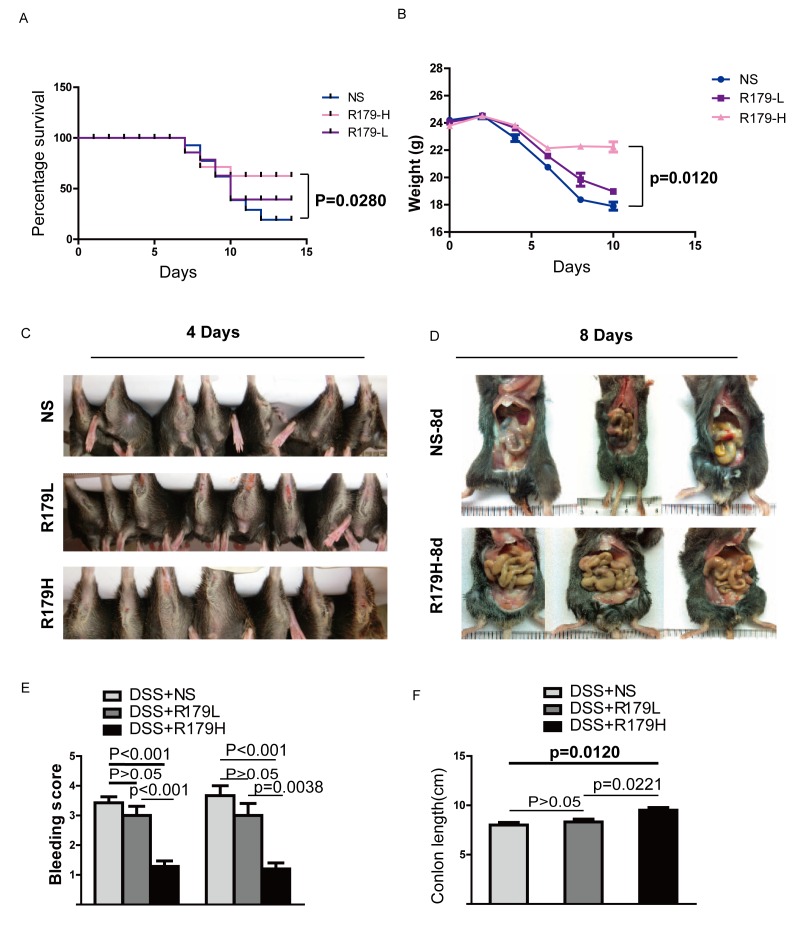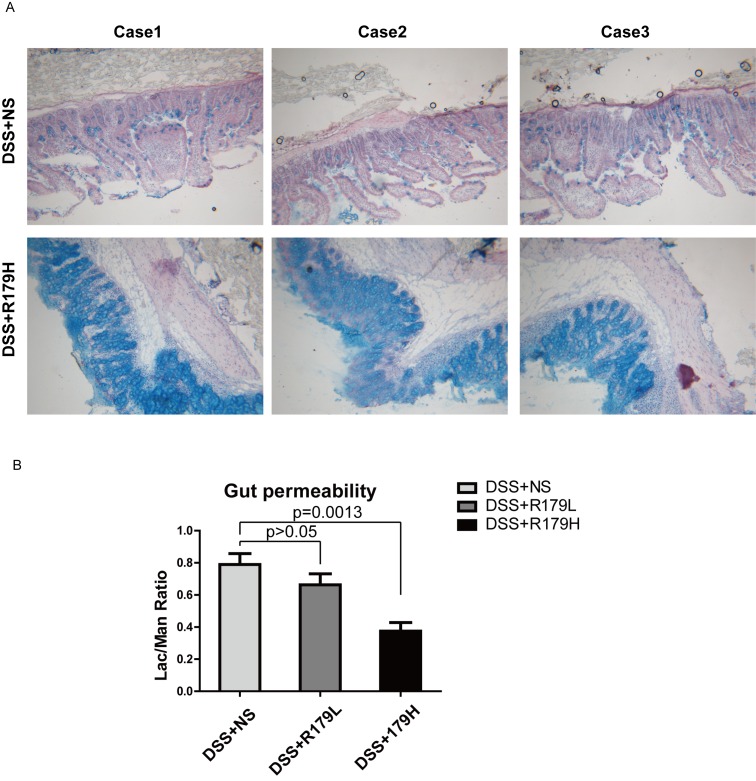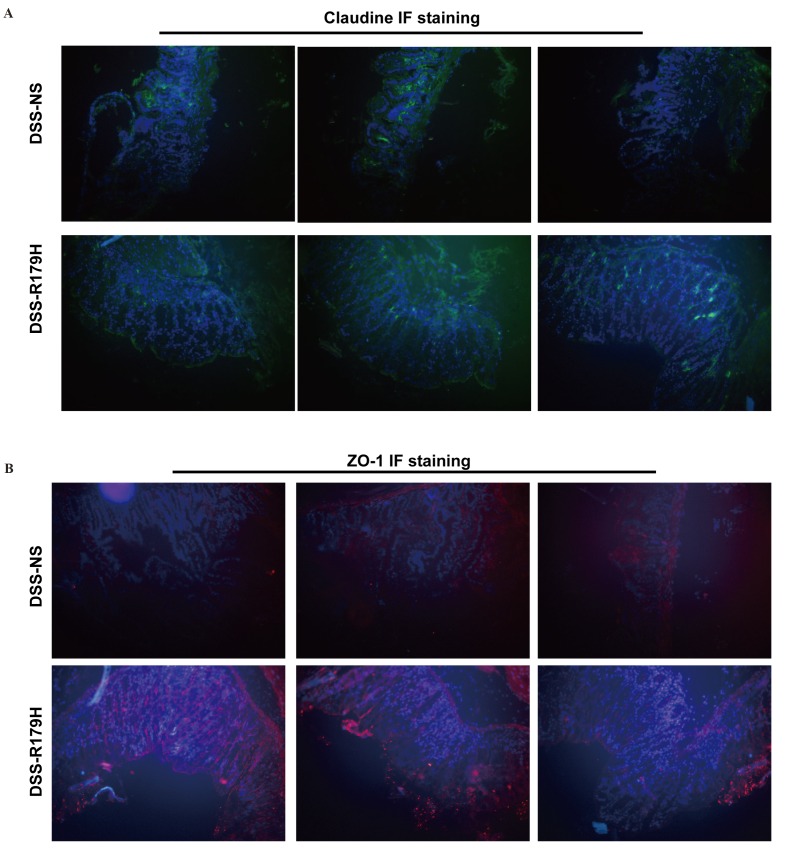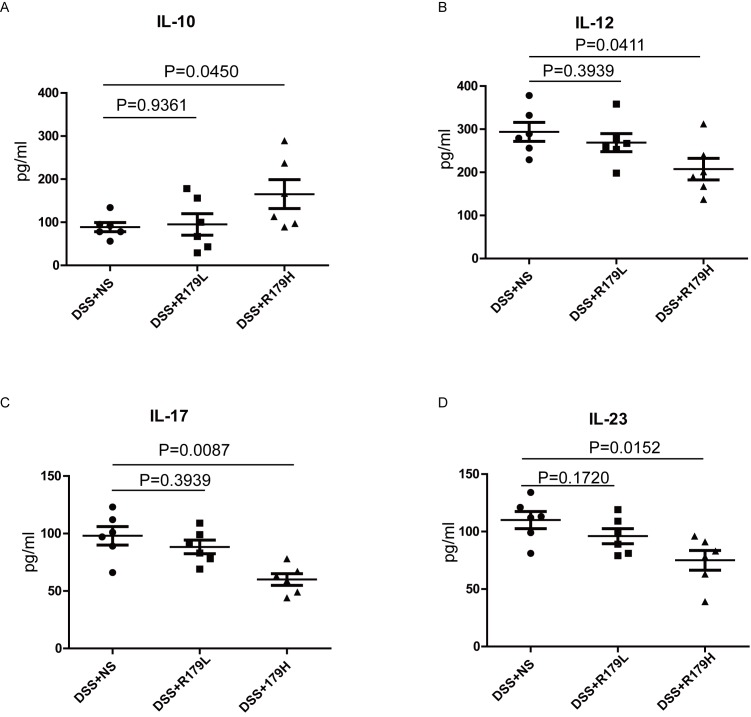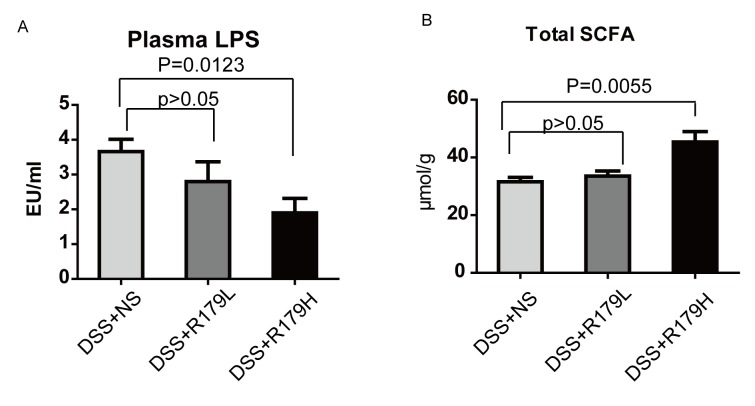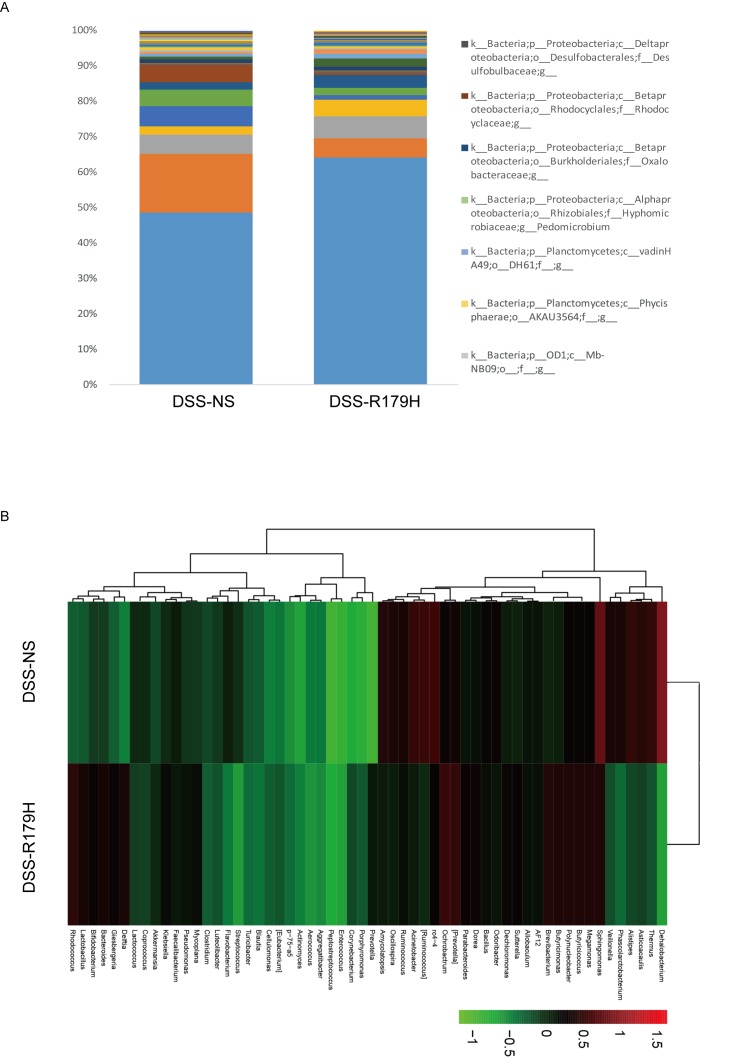Abstract
Gut microbiota composition of patients with ulcerative colitis (UC) is markedly altered compared with healthy individuals. There is mounting evidence that probiotic therapy alleviates disease severity in animal models and patients with inflammatory bowel disease (IBD). Bacillus subtilisis, as a probiotic, has also demonstrated a protective effect in IBD. However, the therapeutic mechanism of its action has yet to be elucidated. In the present study, a dextrose sulfate sodium (DSS)-induced UC mouse model was used to investigate the role of B. subtilis in the restoration of gut flora and determine its effective dose. Mucosal damage was assessed by performing alcian blue staining, cytokine levels were analyzed by ELISA and microbiota composition was investigated using 454 pyrosequencing to target hypervariable regions V3-V4 of the bacterial 16S ribosomal RNA gene. The results demonstrated that a higher dose B. subtilisis administration ameliorated DSS-induced dysbiosis and gut inflammation by balancing beneficial and harmful bacteria and associated anti- and pro-inflammatory agents, thereby aiding intestinal mucosa recovery from DSS-induced injuries. These findings indicate that choosing the correct dose of B. subtilis is important for effective UC therapy. The present study also helped to elucidate the mechanisms of B. subtilis action and provided preclinical data for B. subtilis use in UC therapy.
Keywords: Bacillus subtilis, ulcerative colitis, mouse
Introduction
Ulcerative colitis (UC), which is a subtype of inflammatory bowel disease (IBD) (1), is a chronic and debilitating condition that results in serious intestinal injuries. UC typically occurs as a result of inflammatory dysfunction (2). Patients with UC often exhibit intestinal barrier dysfunction, as well as microbiota and bacterial dysbiosis (3).
Although UC is common, its etiology remains poorly understood (4). In a previous study, epithelial barrier impairment was demonstrated to be associated with low-grade inflammation and dysbiosis as potential causative factors, and are associated with the severity of UC (2). Furthermore, in patients with UC, an increase in gut permeability has previously been associated with the altered expression levels or distribution of tight junction proteins, including occludin and zonula occludens-1 (ZO-1) (5). Therefore, increased intestinal permeability and the occurrence of dysbiosis may be the cause of UC-symptoms (6). The evidence that gut microbiota may have a role in the pathophysiology of UC provides a rationale for probiotic use, which has exhibited beneficial effects (7). However, the therapeutic mechanism of action for the effect of probiotics in UC has yet to be elucidated.
Probiotics are defined as live organisms that exert a health benefit on the host through diverse mechanisms. Bacillus subtilis is a type of probiotic tolerated by humans and animals (8). B. subtilis is hypothesized to affect the composition or function of the commensal, bacterial and host epithelia. Furthermore, it also influences immunological responses and restricts bacterial and lipopolysaccharide (LPS) translocation, and decreases visceral sensitivity (8). In recent clinical trials, probiotics have been widely used to treat disorders of the intestine (7). As enhancement of the intestinal barrier has been associated with the repair of mucosal injuries, the role of B. subtilis treatment in maintaining gut barrier integrity was investigated in the present study, due to its potential usage in the alleviation of UC mucosal injuries.
Changes in the gut microbiota have been associated with IBD, including alterations in the relative abundance of bacteria that are both beneficial and detrimental to gut health, and a decrease in the diversity of the microbiota (9,10). Although previous reports have demonstrated the protective effect of B. subtilis in gut protection (11,12), the impact of B. subtilis administration on gut microbiota alteration remains unknown. The present study aimed to elucidate the role of B. subtilis in the restoration of mucosa, determine its effective dose, and provide preclinical data for B. subtilis usage in UC therapy.
Materials and methods
Modeling of colorectal colitis in mice and treatment
Male C57 mice (body weight, 23±1 g; 6 weeks old) were obtained from the Animal Center, Nanjing Drum Tower Hospital (Nanjing, China) and the in vivo experiment was performed in the same facility. Mice were maintained under controlled conditions (25°C, 55% humidity, 12 h light/dark cycle) and fed standard laboratory food. Mice were administered 3% (wt/vol) dextrose sulfate sodium (DSS) (molecular weight, 35,000–44,000; MP Biomedicals, Inc., Aurora, OH, USA) via drinking water for seven days. Additionally, mice were treated daily with different reagents via gavage (catheter diameter, 1.2 mm), including normal saline (NS; n=8) or B. subtilis (R179; Beijing Hanmi Pharm Co., Ltd., Beijing, China) at a high (1×109 CFU/mouse/day; n=8) or low (1×108 CFU/mouse/day; n=8) dosage until the end of the study. On day eight, mice were weighed and then sacrificed via ether exposure (200 mg/l; Shanghai National Medicine Group, Shanghai, China) in an airtight container in a biosafety cabinet. Colons were harvested, measured and fixed in 4% formalin for subsequent histological examination. Animal experiments were approved by the Ethics Committee of Medical Research, Huashan Hospital of Fudan University (Shanghai, China).
Assessment of colitis
Following the initiation of DSS treatment, daily changes in body weight and clinical signs of colitis, such as rectal bleeding, diarrhea and piloerection, were examined. The disease activity index consisted of scoring for rectal bleeding (0–4), as previously reported (13). Hemoccult SENSA (Beckman Coulter, Inc., Brea, CA, USA) was used to examine rectal bleeding.
Periodic acid-Schiff/alcian blue staining
Alcian blue staining was performed according to a previous report (14). Tissue sections (6 µm thick) were immersed in 100% ethanol for 10 min, rinsed in water for 10 min, immersed in 3% acetic acid for 2 min and subsequently stained in 1% alcian blue 8GX in 3% acetic acid (pH 2.5) for 2.5 h. To remove non-specific staining, 3% acetic acid and water was used to rinse the sections for 10 min. Slides were subsequently oxidized in 1% periodic acid in water at room temperature for 10 min, washed in water for 5 min, immersed in Schiff's reagent for 10 min, rinsed in water for 5 min and three times in 0.5% sodium metabisulphite prior to a final wash in water. To reveal O-acetylated oligosaccharides, sections were treated with 0.1 M KOH for 30 min and 1 mM periodic acid prior to the Schiff reagent.
Immunofluorescence
Frozen tissue sections (6 µm thick) were immunostained with 1:100 primary antibodies against ZO-1 (clonality, H-300; cat. no. sc-10804) and claudin (clonality, D-4; cat. no. sc-137121; species: mouse, rat, human, equine, canine, bovine, porcine) (both Santa Cruz Biotechnology, Inc., Santa Cruz, CA, USA). Images were analyzed using a BIOREVO immunofluorescence microscope (Keyence Corp., Osaka, Japan). Each result was obtained from at least three separate experiments. Six mice per group were prepared for each experiment.
Measurement of intestinal permeability
Intestinal permeability was determined according to a previously described method (15). DSS-treated mice with high/low-dose B. subtilis or control saline (n=5; 4 days) were fasted for 12 h prior to oral gavage of disaccharide permeability probes [100 mg/ml lactulose and 50 mg/ml mannitol (both Sigma-Aldrich; Merck Millipore, Darmstradt, Germany) dissolved in 2 ml water] and urine was collected 12 h later. Urine volume was measured and the concentrations of lactulose and mannitol were determined by high-performance liquid chromatography with an NH2 column (Bischoff Chromatohraphy, Leonberg, Germany) and acetonitrile (70%) based elution. The ratio of the amount of probe in urine to the amount administered as lactulose or mannitol recovery rate was calculated accurately. Intestinal permeability was evaluated as a ratio of lactulose recovery rate to mannitol recovery rate.
Measurement of serum cytokines and endotoxin
On the 4th day following DSS treatment, mice were anesthetized with ether (200 mg/l; Shanghai National Medicine Group) in an airtight container within a biosafety cabinet and blood was collected from the retrobulbar venous plexus using pyrogen-free heparinized syringes. Cytokine [interleukin (IL)-10, IL-12 p70, IL-17A, and IL-23] levels were analyzed by ELISA according to the manufacturer's protocol (R&D Systems, Inc., Minneapolis, MN, USA). Plasma endotoxin was measured using a Limulus amebocyte lysate pyrogen test kit (Xiamen Houshiji, Ltd., Xiamen, China; cat. no. KC48).
Short-chain fatty acid (SCFA) assay
Fresh mice fecal samples were collected from the cages, weighed and stored at −80°C. Fecal samples were mixed with distilled water and centrifuged (2,500 × g). The supernatant was removed, filtered and mixed with ether and sulfuric acid. Following centrifugation (2,500 × g), the ether layer was collected and measured in an Agilent 6890N gas chromatograph machine (Agilent Technologies, Inc., Santa Clara, CA, USA) to determine the total SCFA concentrations.
Microbiological analysis of mice fecal samples
Microbiota composition was assessed by 454 pyrosequencing (GS FLX TI technology, Genoscreen, Lille, France) targeting the V3-V4 region of the bacterial 16S rRNA gene (V3, forward 5′-TACGGRAGGCAGCAG-3′ and V4 reverse 5′-GGACTACCAGGGTATCTAAT-3′). Sequences were binned for a minimal sequence length of 300 pb, a minimal base quality threshold of 30 cycles and a maximum homopolymer length of 6 cycles. Resulting sequences were assigned to different taxonomic levels, from phylum to genus using the Ribosomal Database Project (16). Sequences were further clustered into operational taxonomic units (OTUs) or phylotypes at 97% of identity using the Quantitative Insights into Microbial Ecology pipeline and CD-HIT (17,18). OTUs were assigned to their closest taxonomic neighbors and relative bacterial species using Seqmatch (Michigan State University, East Lansing, MI, USA) and Blastall (National Centre for Biotechnology Information, Bethesda, MD, USA).
Statistical analysis
Data were expressed as the mean ± standard error of the mean. Differences were analyzed using Student's t-test, Chi-square test, or one-way analysis of variance with Tukey's post-hic test for multiple group comparison. P<0.05 was considered to indicate a statistically significant difference.
Results
B. subtilis alleviates DSS-induced lethality and intestinal injuries in mice
To examine the role of B. subtilis in the amelioration of UC in vivo, mice were initially exposed to a lethal dose of 4% DSS (20 ml/d), a pharmacological agent used to induce UC that also causes severe secondary symptoms. Mice were subsequently treated orally with either a high- or low-dose of B. subtilis preparation, or phosphate-buffered saline for control at eight days post-administration. The results indicated that the high dose of B. subtilis solution protected mice from the lethal effect of DSS-induced UC (Fig. 1A). At the end of the study, ~50% survival of probiotic-treated mice was observed. In contrast, only ~1/3 of mice who received normal saline survived for the same period as the high-dose probiotic-treated group and this difference was significant (P=0.0280; Fig. 1A). In addition, a high-dose of B. subtilis administration significantly ameliorated weight loss compared with the normal saline group (P=0.0120; Fig. 1B). As DSS can promote intestinal damage, such as hematochezia and intestinal bleeding, the anuses and intestinal tracts of the three groups were examined. For mice in the high-dose B. subtilis-treated group, the anus and intestinal tract exhibited reduced bleeding and anabrosis than the control and low dose groups (Fig. 1C and D). Mice in the control and low-dose groups suffered more severe colon necrosis and shorter colons compared with the high-dose B. subtilis-treated group (Fig. 1E and F). These results indicate that high-dose B. subtilis administration alleviates DDS-induced colon damage and that B. subtilis induces a dose-dependent effect.
Figure 1.
Bacillus subtilis alleviates DSS-induced lethality and intestinal injuries in mice. (A) Percentage survival rate over time; (B) change in body weight over time; representative image of (C) degree of gut damage and (D) colon length after mice were treated for 8 days; (E) bleeding scores after mice were treated for 4 days; and (F) colon length after mice were treated for 8 days. DSS, dextrose sulfate sodium; NS, normal saline; R179-L, low-dose B. subtilis; R179-H, high-dose B. subtillis.
B. subtilis protects against DSS-induced intestinal mucosal damage in mice
DSS induces UC by causing serious intestinal mucosal damage (19). In accordance with the findings mentioned, low or high doses of B. subtilis may attenuate the symptoms of DSS-induced UC. In light of this, it was hypothesized that B. subtilis may produce its effect by protecting the intestinal mucosa from damage and by reinforcing its repair. To test this hypothesis, alcian blue staining was conducted to determine how the intestinal mucosa reacted to the administration of B. subtilis following DSS treatment. As shown in Fig. 2A, mice treated with high-dose B. subtilis exhibited increased expression levels of mucins compared with the control group, which indicated repair of the colon mucosa. These results suggest that the high dose of the B. subtilis probiotic promoted the restoration of intestinal mucosa.
Figure 2.
Bacillus subtilis protects mouse intestinal mucosal from DSS-induced damage. (A) Mucin was detected by alcian blue staining after mice were treated for 4 days. (B) Detection of intestinal permeability after mice were treated for 4 days. DSS, dextrose sulfate sodium; NS, normal saline; R179L, low-dose B. subtilis; R179H, high-dose B. subtillis.
To further test this hypothesis, intestinal permeability was measured, as DSS-induced intestinal mucosa damage may lead to an increase in intestinal permeability. The results of the present study demonstrated that intestinal permeability was recovered in the B. subtilis-treated group (Fig. 2B). This further supports the hypothesis that treatment with B. subtilis may protect intestinal mucosa from DSS-induced damage and attenuate the inflammatory reaction.
B. subtilis helps to restore tight junctions
The tight junction complex of the intestinal mucosa is considered to be the first ‘firewall’ for gut immunity (20). ZO-1 and claudins are two large families of the tight junction complex. To further explore whether B. subtilis was able to repair DSS-induced damage to the tight junctions, the intestines of mice treated with or without B. subtilis were harvested and probed with ZO-1 and claudins. The samples were then observed under a confocal laser scanning microscope, and the results demonstrated that the two tight junction-associated markers increased following high-dose B. subtilis treatment (Fig. 3A and B). This indicated that B. subtilis was involved in the repair process of DSS-induced mucosal damage and restored the mucosal tight junction complex.
Figure 3.
Bacillus subtilis helps restore tight junctions damaged by DSS. IF staining with the primary antibody (A) claudin and (B) ZO-1. IF, immunofluorescence; DSS, dextrose sulfate sodium; NS, normal saline; R179H, high-dose B. subtillis; ZO-1, zona occludens-1.
B. subtilis administration alleviates systemic inflammation upon DSS treatment
Restoration of intestinal permeability may be related to the relief of the inflammation reaction (21). Therefore, the effect of B. subtilis administration on gut inflammation was explored using ELISA. An increase in plasma cytokines has previously been reported, including IL-12, IL-17 and IL-23, whereas IL-10 decreased in IBD (22). In the present study, the mean plasma levels of IL-12, IL-17 and IL-23 in the high-dose B. subtilis group were significantly reduced (P=0.0411, 0.0087 and 0.0152, respectively) and the mean IL-10 plasma levels were significantly increased (P=0.0450) (Fig. 4) compared with the NS group. However, low-dose B. subtilis treatment produced a less-marked effect.
Figure 4.
Bacillus subtilis administration alleviates DSS-induced systemic inflammation. Serum (A) IL-10, (B) IL-12, (C) IL-17 and (D) IL-23 detection by ELISA. DSS, dextrose sulfate sodium; NS, normal saline; R179L, low-dose B. subtilis; R179H, high-dose B. subtillis; IL, interleukin.
B. subtilis administration balances anti-and pro-inflammatory factors in the gut of mice
Gut microbiota is a primary source of LPS endotoxin, which is a damage-associated pathogen that promotes gut inflammatory reactions and systemic inflammation (23,24). Plasma LPS of mice was tested and a difference in LPS was detected between the high-and low-dose B. subtilis-treated groups and the control group. These results indicated a significant decrease of LPS concentration in the probiotic group with the administration of high-dose B. subtilis compared with the control group (P<0.001; Fig. 5A).
Figure 5.
Bacillus subtilis administration balances anti-and pro-inflammatory factors in the gut. Detection of (A) plasma LPS and (B) fecal total SCFA. LPS, lipopolysaccharide endotoxin; SCFA, short chain fatty acid; DSS, dextrose sulfate sodium; NS, normal saline; R179L, low-dose B. subtilis; R179H, high-dose B. subtillis.
SCFAs have anti-inflammatory functions via interaction with G protein-coupled receptor 43 and have been demonstrated to induce pro-inflammatory cytokines in various models of colitis (25,26). The concentration of total SCFAs was significantly higher in the high-dose B. subtilis group compared with the control group (P=0.0055; Fig. 5B), suggesting that high-dose B. subtilis was beneficial in maintaining SCFA content, which in turn reduced gut inflammation.
B. subtilis administration ameliorates DSS-induced dysbiosis in the gut of mice
There are 100 trillion microorganisms housed in the human body. These microorganisms are maintained as commensals on the gut mucosa, and are associated with metabolism, including maintaining the internal environment and regulating the immune system (27). Consequently, 16s-rDNA sequencing analysis was performed in the present study to examine changes in the microbiota. As demonstrated in Fig. 6, it was observed that the gut microbiota was markedly altered in the high-dose B. subtilis-treated group compared with the control group. Specifically, a reduction of Acinetobacter sp., Ruminococcus sp., Clostridium spp. and Veillonella sp. was detected upon high-dose B. subtilis treatment, whereas levels of Bifidobacterium sp., Lactobacillus sp., and Butyricicoccus sp. were increased. Acinetobacter spp., Ruminococcus spp. Clostridium sp. and Veillonella sp. have been shown to be overrepresented in IBD patients, whereas Bifidobacterium spp., Lactobacillus spp., and Butyricicoccus sp. are decreased (28–32). These results demonstrated the role of B. subtilis in the amelioration of DSS-induced dysbiosis in the gut of model mice.
Figure 6.
Bacillus subtilis administration ameliorates DSS-induced dysbiosis in the gut. (A) Microbiota composition at the genus level in mice after 4 days of treatment with B. subtilis. (B) Heatmap of differentially expressed bacterial genera for NS or high-dose B. subtilis-treated mice (4 days). Mice with the highest and lowest bacterial levels are presented as red and green, respectively. DSS, dextrose sulfate sodium; NS, normal saline; R179H, high-dose B. subtillis.
Discussion
In the present study, DSS was used to induce UC in a mouse model, and treatment with B. subtilis was revealed to markedly decrease the mortality of DSS-treated mice and protect the intestine from further damage. In addition, B. subtilis treatment decreased the damage caused by DSS, which supports the hypothesis that B. subtilis is able to repair epithelial cell injury in intestinal inflammation via immunomodulation (9). Elevated levels of IL-12, IL-17 and IL-23 have previously been found in the epithelial mucosal barrier of subjects with IBD, whereas IL-10 is known to have a protective role in alleviating gut inflammation (9,33,34). Additionally, the present study detected elevated levels of IL-10 and decreased levels of IL-12, IL-17 and IL-23 in the high-dose, but not low-dose, B. subtilis-treatment groups. Therefore, the present study provides evidence that B. subtilis regulates gut immune balance in a dose-dependent manner.
A reduction in the number of SCFA-producing bacteria can result in a degree of focal metabolic stress and vulnerability to inflammatory disease (35). Using gas chromatography, it was determined that B. subtilis administration increased the levels of SCFAs. In addition, a significant increase of the Butyricicoccus spp., which contributes to butyrate generation (36), was detected upon B. subtilis treatment in the present study. Previous studies have shown that the IBD phenotype was associated with lower levels of the clostridial cluster IV genus Butyricicoccus (36,37). These findings indicate that B. subtilis may be beneficial for the survival and expansion of Butyricicoccus spp. under the conditions of gut damage.
A balance of healthy gut commensal bacteria is required for the suppression of pathogenic infections (38), with increasing evidence suggesting that the restoration of normal commensals via transplant is more effective at fighting Clostridium sp. infection than antibiotics (39). Commercially available probiotics, including Lactobacillus and Bifidobacterium spp., are used to attenuate inflammatory activity and prevent relapses in UC (40). In the present study, it was determined that beneficial Bifidobacterium, Lactobacillus, and Butyricicoccus spp. increased in the high-dose B. subtilis-treated groups, compared with the control group. Species known to promote gut damage, such as Acinetobacter sp., Ruminococcus sp., Clostridium spp. and Veillonella sp, were found to be decreased following B. subtilis treatment in the present study. These results indicate the potential role of B. subtilis administration in restoring a healthy balance of beneficial and harmful bacteria in the gut.
In conclusion, dose-dependent B. subtilis administration was demonstrated to aid intestinal mucosa recovery from DSS-induced damage and protect the intestinal mucosa by balancing beneficial and harmful bacterium and their respective, associated anti- and pro-inflammatory agents. The present study elucidated the mechanisms of B. subtilis action and provided preclinical data for B. subtilis use in UC therapy.
Acknowledgements
This study was supported by grants from the Basic Research Program of Beijing Renze Foundation (grant no. ZX-IBD-13002). The authors would like to thank Dong-Ping Hu, Dan-Dan Huang, Shan-Hua Tang, Lin-Na Guo and Dan Cao, Technicians from the International Cooperation Laboratory on Signal Transduction (Eastern Hepatobiliary Surgery Hospital, Second Military Medical University, Shanghai, China), for their technical assistance.
References
- 1.Mosli MH, Feagan BG, Sandborn WJ, D'Haens G, Behling C, Kaplan K, Driman DK, Shackelton LM, Baker KA, Macdonald JK, et al. Histologic evaluation of ulcerative colitis: A systematic review of disease activity indices. Inflamm Bowel Dis. 2014;20:564–575. doi: 10.1097/01.MIB.0000437986.00190.71. [DOI] [PubMed] [Google Scholar]
- 2.Rosenberg L, Nanda KS, Zenlea T, Gifford A, Lawlor GO, Falchuk KR, Wolf JL, Cheifetz AS, Goldsmith JD, Moss AC. Histologic markers of inflammation in patients with ulcerative colitis in clinical remission. Clin Gastroenterol Hepatol. 2013;11:991–996. doi: 10.1016/j.cgh.2013.02.030. [DOI] [PMC free article] [PubMed] [Google Scholar]
- 3.Manichanh C, Borruel N, Casellas F, Guarner F. The gut microbiota in IBD. Nat Rev Gastroenterol Hepatol. 2012;9:599–608. doi: 10.1038/nrgastro.2012.152. [DOI] [PubMed] [Google Scholar]
- 4.Conrad K, Roggenbuck D, Laass MW. Diagnosis and classification of ulcerative colitis. Autoimmun Rev. 2014;13:463–466. doi: 10.1016/j.autrev.2014.01.028. [DOI] [PubMed] [Google Scholar]
- 5.Suzuki T. Regulation of intestinal epithelial permeability by tight junctions. Cell Mol Life Sci. 2013;70:631–659. doi: 10.1007/s00018-012-1070-x. [DOI] [PMC free article] [PubMed] [Google Scholar]
- 6.Buning C, Geissler N, Prager M, Sturm A, Baumgart DC, Büttner J, Bühner S, Haas V, Lochs H. Increased small intestinal permeability in ulcerative colitis: Rather genetic than environmental and a risk factor for extensive disease? Inflamm Bowel Dis. 2012;18:1932–1939. doi: 10.1002/ibd.22909. [DOI] [PubMed] [Google Scholar]
- 7.Shen J, Zuo ZX, Mao AP. Effect of probiotics on inducing remission and maintaining therapy in ulcerative colitis, Crohn's disease, and pouchitis: Meta-analysis of randomized controlled trials. Inflamm Bowel Dis. 2014;20:21–35. doi: 10.1097/01.MIB.0000437495.30052.be. [DOI] [PubMed] [Google Scholar]
- 8.Aly SM, Ahmed Y Abdel-Galil, Abdel-Aziz Ghareeb A, Mohamed MF. Studies on Bacillus subtilis and Lactobacillus acidophilus, as potential probiotics, on the immune response and resistance of Tilapia nilotica (Oreochromis niloticus) to challenge infections. Fish Shellfish Immunol. 2008;25:128–136. doi: 10.1016/j.fsi.2008.03.013. [DOI] [PubMed] [Google Scholar]
- 9.Sarra M, Pallone F, Macdonald TT, Monteleone G. IL-23/IL-17 axis in IBD. Inflamm Bowel Dis. 2010;16:1808–1813. doi: 10.1002/ibd.21248. [DOI] [PubMed] [Google Scholar]
- 10.Nell S, Suerbaum S, Josenhans C. The impact of the microbiota on the pathogenesis of IBD: Lessons from mouse infection models. Nat Rev Microbiol. 2010;8:564–577. doi: 10.1038/nrmicro2403. [DOI] [PubMed] [Google Scholar]
- 11.Okamoto K, Fujiya M, Nata T, Ueno N, Inaba Y, Ishikawa C, Ito T, Moriichi K, Tanabe H, Mizukami Y, et al. Competence and sporulation factor derived from Bacillus subtilis improves epithelial cell injury in intestinal inflammation via immunomodulation and cytoprotection. Int J Colorectal Dis. 2012;27:1039–1046. doi: 10.1007/s00384-012-1416-8. [DOI] [PubMed] [Google Scholar]
- 12.Selvam R, Maheswari P, Kavitha P, Ravichandran M, Sas B, Ramchand CN. Effect of Bacillus subtilis PB6, a natural probiotic on colon mucosal inflammation and plasma cytokines levels in inflammatory bowel disease. Indian J Biochem Biophys. 2009;46:79–85. [PubMed] [Google Scholar]
- 13.Axelsson LG, Landström E, Goldschmidt TJ, Grönberg A, Bylund-Fellenius AC. Dextran sulfate sodium (DSS) induced experimental colitis in immunodeficient mice: Effects in CD4(+)-cell depleted, athymic and NK-cell depleted SCID mice. Inflamm Res. 1996;45:181–191. doi: 10.1007/BF02285159. [DOI] [PubMed] [Google Scholar]
- 14.Lindén SK, Florin TH, McGuckin MA. Mucin dynamics in intestinal bacterial infection. PLoS One. 2008;3:e3952. doi: 10.1371/journal.pone.0003952. [DOI] [PMC free article] [PubMed] [Google Scholar]
- 15.Olson TS, Reuter BK, Scott KG, Morris MA, Wang XM, Hancock LN, Burcin TL, Cohn SM, Ernst PB, Cominelli F, et al. The primary defect in experimental ileitis originates from a nonhematopoietic source. J Exp Med. 2006;203:541–552. doi: 10.1084/jem.20050407. [DOI] [PMC free article] [PubMed] [Google Scholar]
- 16.Cole JR, Wang Q, Cardenas E, Fish J, Chai B, Farris RJ, Kulam-Syed-Mohideen AS, McGarrell DM, Marsh T, Garrity GM, Tiedje JM. The ribosomal database project: Improved alignments and new tools for rRNA analysis. Nucleic Acids Res. 2009;37:D141–D145. doi: 10.1093/nar/gkn879. (Database Issue) [DOI] [PMC free article] [PubMed] [Google Scholar]
- 17.Li W, Godzik A. Cd-hit: A fast program for clustering and comparing large sets of protein or nucleotide sequences. Bioinformatics. 2006;22:1658–1659. doi: 10.1093/bioinformatics/btl158. [DOI] [PubMed] [Google Scholar]
- 18.Caporaso JG, Kuczynski J, Stombaugh J, Bittinger K, Bushman FD, Costello EK, Fierer N, Peñna AG, Goodrich JK, Gordon JI, et al. QIIME allows analysis of high-throughput community sequencing data. Nat Methods. 2010;7:335–336. doi: 10.1038/nmeth.f.303. [DOI] [PMC free article] [PubMed] [Google Scholar]
- 19.Chassaing B, Aitken JD, Malleshappa M, Vijay-Kumar M. Dextran sulfate sodium (DSS)-induced colitis in mice. Curr Protoc Immunol. 2014;104 doi: 10.1002/0471142735.im1525s104. Unit 15-25. [DOI] [PMC free article] [PubMed] [Google Scholar]
- 20.Goto Y, Kurashima Y, Kiyono H. Roles of the gut mucosal immune system in symbiosis and immunity. Rinsho Ketsueki. 2015;56:2205–2212. doi: 10.11406/rinketsu.56.2205. (In Japanese) [DOI] [PubMed] [Google Scholar]
- 21.Genser L, Poitou C, Brot-Laroche É, Rousset M, Vaillant JC, Clément K, Thenet S, Leturque A. Alteration of intestinal permeability: The missing link between gut microbiota modifications and inflammation in obesity? Med Sci (Paris) 2016;32:461–469. doi: 10.1051/medsci/20163205012. (In French) [DOI] [PubMed] [Google Scholar]
- 22.Fujino S, Andoh A, Bamba S, Ogawa A, Hata K, Araki Y, Bamba T, Fujiyama Y. Increased expression of interleukin 17 in inflammatory bowel disease. Gut. 2003;52:65–70. doi: 10.1136/gut.52.1.65. [DOI] [PMC free article] [PubMed] [Google Scholar]
- 23.Calvano SE, Xiao W, Richards DR, Felciano RM, Baker HV, Cho RJ, Chen RO, Brownstein BH, Cobb JP, Tschoeke SK, et al. A network-based analysis of systemic inflammation in humans. Nature. 2005;437:1032–1037. doi: 10.1038/nature03985. [DOI] [PubMed] [Google Scholar]
- 24.Cetin S, Ford HR, Sysko LR, Agarwal C, Wang J, Neal MD, Baty C, Apodaca G, Hackam DJ. Endotoxin inhibits intestinal epithelial restitution through activation of Rho-GTPase and increased focal adhesions. J Biol Chem. 2004;279:24592–24600. doi: 10.1074/jbc.M313620200. [DOI] [PubMed] [Google Scholar]
- 25.Maslowski KM, Vieira AT, Ng A, Kranich J, Sierro F, Yu D, Schilter HC, Rolph MS, Mackay F, Artis D, et al. Regulation of inflammatory responses by gut microbiota and chemoattractant receptor GPR43. Nature. 2009;461:1282–1286. doi: 10.1038/nature08530. [DOI] [PMC free article] [PubMed] [Google Scholar]
- 26.Mirmonsef P, Zariffard MR, Gilbert D, Makinde H, Landay AL, Spear GT. Short-chain fatty acids induce pro-inflammatory cytokine production alone and in combination with toll-like receptor ligands. Am J Reprod Immunol. 2012;67:391–400. doi: 10.1111/j.1600-0897.2011.01089.x. [DOI] [PMC free article] [PubMed] [Google Scholar]
- 27.Magri G, Cerutti A. A touch of youth in gut microbiota development. Immunity. 2016;45:12–14. doi: 10.1016/j.immuni.2016.07.002. [DOI] [PubMed] [Google Scholar]
- 28.Bergogne-Bérézin E, Towner KJ. Acinetobacter spp. as nosocomial pathogens: Microbiological, clinical, and epidemiological features. Clin Microbiol Rev. 1996;9:148–165. doi: 10.1128/cmr.9.2.148. [DOI] [PMC free article] [PubMed] [Google Scholar]
- 29.Sokol H, Leducq V, Aschard H, Pham HP, Jegou S, Landman C, Cohen D, Liguori G, Bourrier A, Nion-Larmurier I, et al. Fungal microbiota dysbiosis in IBD. Gut. 2016;pii doi: 10.1136/gutjnl-2015-310746. gutjnl-2015-310746. [DOI] [PMC free article] [PubMed] [Google Scholar]
- 30.Nones K, Knoch B, Dommels YE, Paturi G, Butts C, McNabb WC, Roy NC. Multidrug resistance gene deficient (mdr1a-/-) mice have an altered caecal microbiota that precedes the onset of intestinal inflammation. J Appl Microbiol. 2009;107:557–566. doi: 10.1111/j.1365-2672.2009.04225.x. [DOI] [PubMed] [Google Scholar]
- 31.Kummen M, Holm K, Anmarkrud JA, Nygård S, Vesterhus M, Høivik ML, Trøseid M, Marschall HU, Schrumpf E, Moum B, et al. The gut microbial profile in patients with primary sclerosing cholangitis is distinct from patients with ulcerative colitis without biliary disease and healthy controls. Gut. 2016;pii doi: 10.1136/gutjnl-2015-310500. gutjnl-2015-310500. [DOI] [PubMed] [Google Scholar]
- 32.Gevers D, Kugathasan S, Denson LA, Vázquez-Baeza Y, van Treuren W, Ren B, Schwager E, Knights D, Song SJ, Yassour M, et al. The treatment-naive microbiome in new-onset Crohn's disease. Cell Host Microbe. 2014;15:382–392. doi: 10.1016/j.chom.2014.02.005. [DOI] [PMC free article] [PubMed] [Google Scholar]
- 33.Schreiber S, Heinig T, Thiele HG, Raedler A. Immunoregulatory role of interleukin 10 in patients with inflammatory bowel disease. Gastroenterology. 1995;108:1434–1444. doi: 10.1016/0016-5085(95)90692-4. [DOI] [PubMed] [Google Scholar]
- 34.Steinbach EC, Plevy SE. The role of macrophages and dendritic cells in the initiation of inflammation in IBD. Inflamm Bowel Dis. 2014;20:166–175. doi: 10.1097/MIB.0b013e3182a69dca. [DOI] [PMC free article] [PubMed] [Google Scholar]
- 35.Schoultz I, Söderholm JD, McKay DM. Is metabolic stress a common denominator in inflammatory bowel disease? Inflamm Bowel Dis. 2011;17:2008–2018. doi: 10.1002/ibd.21556. [DOI] [PubMed] [Google Scholar]
- 36.Eeckhaut V, Machiels K, Perrier C, Romero C, Maes S, Flahou B, Steppe M, Haesebrouck F, Sas B, Ducatelle R, et al. Butyricicoccus pullicaecorum in inflammatory bowel disease. Gut. 2013;62:1745–1752. doi: 10.1136/gutjnl-2012-303611. [DOI] [PubMed] [Google Scholar]
- 37.Frank DN, Robertson CE, Hamm CM, Kpadeh Z, Zhang T, Chen H, Zhu W, Sartor RB, Boedeker EC, Harpaz N, et al. Disease phenotype and genotype are associated with shifts in intestinal-associated microbiota in inflammatory bowel diseases. Inflamm Bowel Dis. 2011;17:179–184. doi: 10.1002/ibd.21339. [DOI] [PMC free article] [PubMed] [Google Scholar]
- 38.Kamada N, Kim YG, Sham HP, Vallance BA, Puente JL, Martens EC, Núñez G. Regulated virulence controls the ability of a pathogen to compete with the gut microbiota. Science. 2012;336:1325–1329. doi: 10.1126/science.1222195. [DOI] [PMC free article] [PubMed] [Google Scholar]
- 39.van Nood E, Vrieze A, Nieuwdorp M, Fuentes S, Zoetendal EG, de Vos WM, Visser CE, Kuijper EJ, Bartelsman JF, Tijssen JG, et al. Duodenal infusion of donor feces for recurrent Clostridium difficile. N Engl J Med. 2013;368:407–415. doi: 10.1056/NEJMoa1205037. [DOI] [PubMed] [Google Scholar]
- 40.Meijer BJ, Dieleman LA. Probiotics in the treatment of human inflammatory bowel diseases: Update 2011. J Clin Gastroenterol. 2011;45(Suppl):S139–S144. doi: 10.1097/MCG.0b013e31822103f7. [DOI] [PubMed] [Google Scholar]



